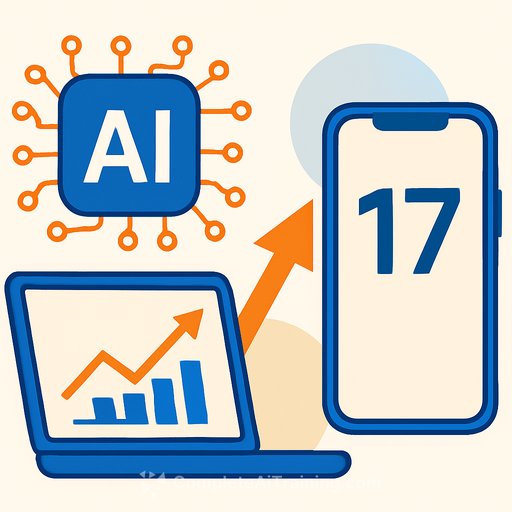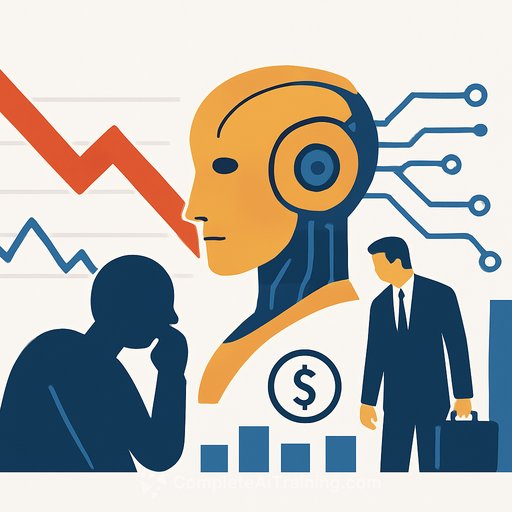Big Tech earnings: AI spend, cloud growth, and Apple's iPhone 17 are the catalysts to watch
It's a stacked week. Google, Meta, and Microsoft report after the bell Wednesday, followed by Amazon and Apple on Thursday. AMD and Nvidia arrive later on Nov. 4 and Nov. 19. If you're managing risk or positioning into year-end, this is one of the most consequential stretches of 2025.
The market will key in on two themes: AI's impact on cloud and ads, and whether Apple's iPhone 17 cycle is strong enough to support its fresh $4T valuation. Expect volatility - and opportunity - as guidance and capex plans reset expectations.
Why AI and cloud will set the tone
Street conversations are leaning more positive on cloud going into the print. UBS channel checks point to stronger sentiment at Amazon, Google, and Microsoft than in prior quarters. Still, performance dispersion is real: year to date, Amazon's stock is up a little over 4%, while Google is up ~40% and Microsoft ~30%.
For the quarter, estimates cited by UBS call for cloud growth around 39% at Azure and 32% at Google Cloud, versus ~17% for AWS. The gap is tied less to core workload share and more to outsized AI compute demand - OpenAI on Azure and rising Gemini usage on Google - pulling forward growth.
Strip out the OpenAI tailwind and Azure growth drops to an estimated 22% compared with ~15% for AWS. That spread is narrower and more explainable given AWS's larger ex-AI base. Translation: investors want cleaner proof that AWS is plugged into high-margin AI compute at scale.
Company-by-company: what to listen for
Amazon (AMZN)
- AWS growth vs. AI exposure: Can management quantify AI compute workloads, Trainium2 traction, and how Anthropic's usage balances its new deal to use up to 1 million Google chips?
- Project Rainier: Details on the Trainium2 supercluster, timelines, and how capacity ramps convert to revenue and margin mix.
- Resilience post-outage: Last week's global AWS outage didn't dent the stock; investors will look for churn metrics, service credits, and prevention roadmaps.
- Capex and supply: Guidance on 2026 GPU/AI chip availability and networking constraints will drive sentiment as much as revenue.
Google (GOOG, GOOGL)
- Google Cloud Platform: Management previously called a $50B run rate and strong AI demand. Look for large deal commentary, GPU utilization, and AI gross margin trajectory.
- Ads with GenAI search: BofA notes advertisers are shifting spend to paid to offset weaker organic traffic. Watch CPC, click growth, and any color on GenAI's net impact on ad load.
- Chrome vs. new entrants: OpenAI's ChatGPT Atlas browser adds competitive noise, but Chrome's ~72% share leaves a long runway. Any mention of enterprise retention or default status matters.
Microsoft (MSFT)
- OpenAI demand: Strong GPU utilization from OpenAI is a tailwind, but the Street needs proof that Azure's growth is healthy beyond AI workloads.
- OpenAI agreement shift: Microsoft loses first right of refusal as OpenAI's cloud provider, but OpenAI has committed $250B to Azure. Expect questions on duration, cadence, and how that spend flows through bookings and revenue.
- AI monetization beyond infra: Copilot attach, pricing, and seat penetration are key to diversifying AI-driven growth.
Meta (META)
- Ad engine and engagement: AI has boosted relevance and yield, but spending billions on data centers raises the bar. Investors want continuing gains in impression growth and pricing without margin erosion.
- Comparison risk vs. Google: Reporting the same day sets up a clean read-through on ad budgets. A beat relative to Google could spark a move; a miss could do the opposite.
- Hardware as a lead indicator: New smart glasses with a display are early, but any signal that they lift engagement - and future advertiser interest - will get attention.
Apple (AAPL)
- iPhone 17 launch strength: Counterpoint Research says the 17 lineup outsold the 16 by 14% in the first 10 days in the US and China. That momentum helped lift Apple to a $4T market cap, making it the third company to cross the mark after Nvidia and Microsoft (which has since dipped below).
- Watch the trend, not just the open: Jefferies notes lead times are easing in multiple markets - a sign launch heat could be cooling. The Street will want clarity on mix, carrier promos, and geographic splits.
- iPhone Air vs. Plus: Expect direct questions on whether the Air is outperforming the Plus it replaced and what that means for margins and ASPs.
- Apple Intelligence timing: AI-enhanced Siri is coming, but near-term numbers still live and die by iPhone sell-through, upgrades, and services attach.
The setup for price action
- Capex signals: Any step-up in data center capex implies confidence in AI demand and can lift suppliers while pressuring near-term free cash flow.
- Supply constraints: If GPU or networking limits persist into 2026, expect prioritization toward the highest-ROI workloads - a positive for pricing and margins, but a cap on unit volume.
- AI mix shift: Higher AI compute mix can expand gross margin in cloud - if pricing holds and utilization stays high.
- Ads vs. organic: If GenAI answers dampen organic traffic, sustained advertiser shifts to paid could support CPC and offset volume volatility.
Key dates still ahead
- AMD: Nov. 4
- Nvidia: Nov. 19
What matters most for finance teams
Keep your attention on disclosures that help you underwrite 2026-2027 free cash flow: AI capex cadence, cloud utilization, per-customer AI spend, and any changes to depreciation schedules. For Apple, focus on iPhone mix, regional growth, and services attach lifting gross margin through the cycle.
If there's a surprise, it likely comes from either stronger AI-driven Azure growth than feared excluding OpenAI, or an AWS AI inflection supported by Trainium2 production and Anthropic workloads. On the consumer side, a sustained iPhone 17 mix toward higher storage SKUs would be a quiet win for margins.
Quick checklist for your model
- Azure, GCP, AWS: growth rates, AI as percent of workloads, GPU utilization, and gross margin trend
- Capex and opex: data center spend, chip commitments, networking investments, useful life assumptions
- Ads: CPC, impressions, Reels/shorts monetization, and impact from GenAI search experiences
- Apple: iPhone units and ASP, channel inventory, lead times by region, Services gross margin
- Guidance quality: visibility into AI demand and supply, bookings to revenue conversion, and FX
Bottom line: this week will reset the narrative around who is capturing AI dollars today and who is still building for tomorrow - and whether the iPhone 17 cycle can carry Apple's $4T story into 2026. Trade the numbers, not the headlines.
For analysts building faster workflows around transcripts, models, and repeatable research, these resources may help: AI tools for finance.
Related reading: Counterpoint Research
Your membership also unlocks:






